Airmodel 1/72 DFS-230 Assault Glider
|
KIT: |
Airmodel 1/72 DFS-230 Assault Glider |
|
KIT #: |
? |
|
PRICE: |
€5.00 |
|
DECALS: |
None provided |
|
REVIEWER: |
Carmel J. Attard |
|
NOTES: |
Vacuformed kit. |
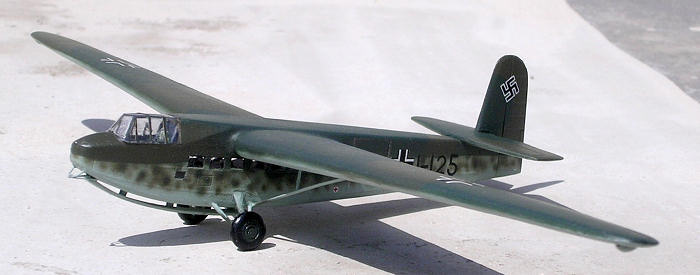
In 1939,
Germany,
like
Russia,
had a large force of airborne troops. These were capable of being dropped from
Ju52/3m transport aircraft or as it happened on
the 10th
of May 1940,
carried in by
gliders.
On that day the whole success of capturing the Belgian fort at Eben Emael
depended upon getting a small force of assault troops within the walls of the
fortress and it was the DFS 230 that made the capture possible, owing to their
completely silent arrival.
The
development of the DFS 230 goes back to 1937 when after military interests a
contract was awarded for an initial construction of six prototypes. Subsequently
it demonstrated successfully that resulted in a type order into a limited
production
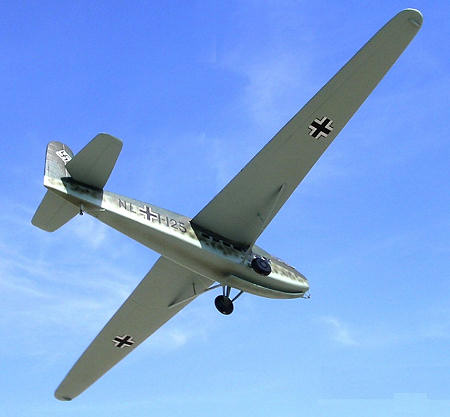 as DFS 230 A-1. The total production reached 1,510 aircraft. The
glider provided an accommodation for a crew of two and eight fully armed troops
which were accommodated in tandem seating facing backwards inside the aircraft
fuselage. The DFS 230 used jettisonable landing gear
for take off, and landed
on a central skid mounted under the forward fuselage.
as DFS 230 A-1. The total production reached 1,510 aircraft. The
glider provided an accommodation for a crew of two and eight fully armed troops
which were accommodated in tandem seating facing backwards inside the aircraft
fuselage. The DFS 230 used jettisonable landing gear
for take off, and landed
on a central skid mounted under the forward fuselage.
Until the day of the successful capture of the Belgian
Fort in May 1940 the DFS 230 was a secret weapon of war and a year later the
element of surprise was completely lost and only sheer
numbers could make an impression during the successful invasion of
Crete.
The cost in transport loss was so enormous that operations such as the planned
attack on the strategic
island
of
Malta
was postponed until shelved indefinitely. At the time
of the meticulous plan,
Malta
was in a dire situation, literally in need of all essential supplies in order to
remain standing. There was no aviation fuel, ammunition being exhausted,
inadequate defensive fighter aircraft, and complete lack of essential food
staffs, most especially wheat. Looking hindsight the
Malta
operation was possibly among the blunders by the German regime at the time of
the war in
Europe.
Perhaps it was a divine intervention that this situation evolved at a time when
events in Russia were
going from bad to worse for Germany
and all the war supplies were heading in that direction. The defensive
fortifications, bastions and walls of
Valletta
from where the Grand Master of the Order of
St
John
along with the local inhabitants had struck a crippling blow to the 35,000
strong Turkish Armada during the Great Siege of Malta in 1565 were of no use 350
years later. The walls had adequate AA guns to protect the port and Admiralty
Dockyard but elsewhere on the island there was literally nothing that could have
halted an all out German invasion with a full force of DFS 230 had the plan went
ahead.
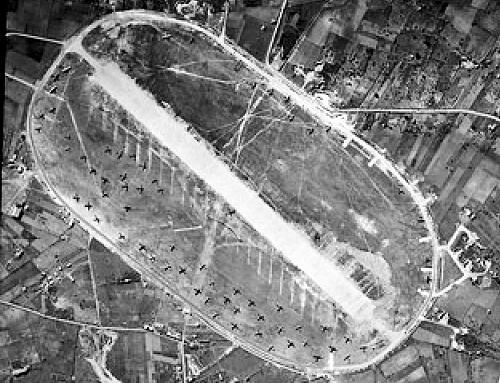 RAF reconnaissance flights conducted over airfields in
Sicily
brought back evidence of an immense number of DFS 230 gliders being amassed for
this planned
Malta
operation. Had this plan moved forward the adverse effect for the allies would
have been catastrophic. But the loss on the German
force would have been very high as morale on the island was high against such an
eventuality.
RAF reconnaissance flights conducted over airfields in
Sicily
brought back evidence of an immense number of DFS 230 gliders being amassed for
this planned
Malta
operation. Had this plan moved forward the adverse effect for the allies would
have been catastrophic. But the loss on the German
force would have been very high as morale on the island was high against such an
eventuality.
In due course the strategic island was replenished via
convoys. Locally based aircraft from five air bases on the island struck endless
blows on axis shipping that was starving the African campaign from most
essential war supplies. Even to this day, deep sea divers are astonished at how
the sea bed all around the island and further off shore is still littered with
sunken ships and war material such as an innumerable number of aircraft engines.
Apart from this unaccomplished issue there still
remained many tasks for this cheap and efficient glider transport. The seats
could be quickly removed to make way for other internal loads. So much so the
DFS 230 also saw service in supply missions on the Eastern Front.
The DFS 230 had a gliding speed of 180 mph. It had a
wing span of 72’ 1.3 “ and a length of 36’ 10.5“Carried an armament of 2x .312“
MG34 fixed forward firing machine guns in the nose and one .312“ in upper
fuselage decking.
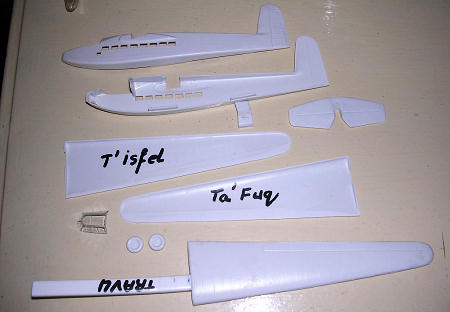 Airmodel vac-form kit No 287 comes in polythene bag, containing a single sheet
of white plastic containing the principal vac form parts comprising two fuselage
halves, 8 parts for the main and tail planes, and a clear acetate vac form
canopy is also included. The 4-page A4 size instruction sheet contains a brief
history of the glider, assembly instructions, a three view 1/72 scale plans, an
exploded assembly view and a cutaway drawing of the forward fuselage that shows
internal detail. Small items such as the control column, floor, seats,
instrument panel, u/c legs, struts which are shown in detail must be self made.
There are also vac form wheel set. The kit was checked for dimensions and was
found to conform to a scale of 1/73 making the kit a tiny bit smaller than if it
was a true 1/72 scale.
Airmodel vac-form kit No 287 comes in polythene bag, containing a single sheet
of white plastic containing the principal vac form parts comprising two fuselage
halves, 8 parts for the main and tail planes, and a clear acetate vac form
canopy is also included. The 4-page A4 size instruction sheet contains a brief
history of the glider, assembly instructions, a three view 1/72 scale plans, an
exploded assembly view and a cutaway drawing of the forward fuselage that shows
internal detail. Small items such as the control column, floor, seats,
instrument panel, u/c legs, struts which are shown in detail must be self made.
There are also vac form wheel set. The kit was checked for dimensions and was
found to conform to a scale of 1/73 making the kit a tiny bit smaller than if it
was a true 1/72 scale.
In same way as any other vac form kit, the parts are
first scored with a sharp knife and snapped from the backing sheet. These were
sanded down and checked for correction using outside calliper and the scale
drawings given. Non kit parts are made and checked for fit. Cockpit floor was
first assembled o the forward fuselage, Crew seats and instrument coaming added.
Fuselage interior and cock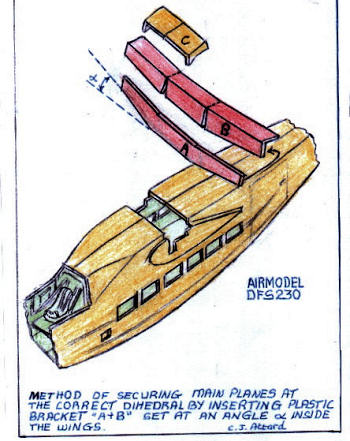 pit detail was painted. Fuselage windows were cut open
using a twist drill followed by shaping with a pointed carving blade. Half of
the fuselage was then assembled adding most of the interior: floor, seats etc.
Small plastic guide tabs were glued to inside edge to assist in a self aligning
secure joint. I used Humbrol liquid cement to fix parts together. Instructions
suggested fixing a balsa spar through the fuselage centre section. I preferred
to make a plastic spar of L section from surplus plastic backing sheet (see
sketch). This consisted of an L shaped beam ‘B’ and an interior spar ‘A’ which
will have the dihedral of the wing at an angle checked from the scale plans. The
upper fuselage had a roof section ‘C’ cut to allow the Beam A+B to fit inside.
Once assembled the upper wing was first attached to flat part of item B and the
lower wings were then fixed with the upper.
pit detail was painted. Fuselage windows were cut open
using a twist drill followed by shaping with a pointed carving blade. Half of
the fuselage was then assembled adding most of the interior: floor, seats etc.
Small plastic guide tabs were glued to inside edge to assist in a self aligning
secure joint. I used Humbrol liquid cement to fix parts together. Instructions
suggested fixing a balsa spar through the fuselage centre section. I preferred
to make a plastic spar of L section from surplus plastic backing sheet (see
sketch). This consisted of an L shaped beam ‘B’ and an interior spar ‘A’ which
will have the dihedral of the wing at an angle checked from the scale plans. The
upper fuselage had a roof section ‘C’ cut to allow the Beam A+B to fit inside.
Once assembled the upper wing was first attached to flat part of item B and the
lower wings were then fixed with the upper.
Bracing struts were added to fuselage to wings. A
landing skid was shaped from plastic card and fitted under the forward fuselage
with three support brackets shaped from stretch sprue. I preferred to replace
the wheels with an injection moulded set of same diameter and format. Other
detail items as the towing arm at the nose, the tail skid were built up from
thin steel wire and fixed in place at pre drilled holes using super glue. A pair
of wing tip skids were shaped from plastic and fitted in place. Fitting of the
tail plane necessitated scraping of lower tail fin root so that the tail plane
was semi immersed in the fuselage. These were then glued in place. The cockpit
canopy was cut to size and fixed with white glue. In the end joint seams were
checked once more and any excess filler rubbed down. Trim tabs were engraved to
lower rudder and tail planes. The glider model was now ready for painting.
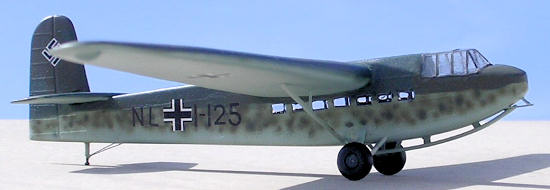 The
DFS 230 cockpit and troop area / cargo area was RLM 02 grey and adding dark
shades at various areas. The exterior was in standard Luftwaffe scheme of RLM 70
and 71 at upper surfaces and RLM 65 to lower surfaces using White Ensign Model
colour paint. The matt colours were given a coat of semi gloss floor polish
liquid. This was essential to allow the decals to have better adherence
properties. Allmark decals were used for the German insignia and swastika.
Finally the kit was given two coats
of semi matt clear varnish of Model Master Brand and allowed to set.
The
DFS 230 cockpit and troop area / cargo area was RLM 02 grey and adding dark
shades at various areas. The exterior was in standard Luftwaffe scheme of RLM 70
and 71 at upper surfaces and RLM 65 to lower surfaces using White Ensign Model
colour paint. The matt colours were given a coat of semi gloss floor polish
liquid. This was essential to allow the decals to have better adherence
properties. Allmark decals were used for the German insignia and swastika.
Finally the kit was given two coats
of semi matt clear varnish of Model Master Brand and allowed to set.
 Allowing the little extra work that was needed the kit
assembled well. It was the glider type connection with
Malta
that made me build it. In spite of all, the DFS 230 played a vital part in the
history of WWII. However, failure to use it in the cancelled Malta Operation
remains a definite false move by
Germany
and certainly a deep breadth of fresh air for
Malta
and the allies. Outside the
UK
the island remained the sole defiant spot in the war against
Germany
in
Europe
and was dabbed ‘The unsinkable aircraft carrier’ by Sir Winston Churchill.
Allowing the little extra work that was needed the kit
assembled well. It was the glider type connection with
Malta
that made me build it. In spite of all, the DFS 230 played a vital part in the
history of WWII. However, failure to use it in the cancelled Malta Operation
remains a definite false move by
Germany
and certainly a deep breadth of fresh air for
Malta
and the allies. Outside the
UK
the island remained the sole defiant spot in the war against
Germany
in
Europe
and was dabbed ‘The unsinkable aircraft carrier’ by Sir Winston Churchill.
Carmel J. Attard
May 2008
Edotor's note. For those of you would would like to build a model of
this important military glider, but who have 'vacuphobia', Huma makes a nice
injected version in 1/72 and Special Hobby did one in 1/48. Reviews of both can
be found in the archives.
If you would like your product reviewed fairly and quickly, please
contact
me or see other details in the
Note to
Contributors.
Back to the Main Page
Back to the Review
Index Page


 as DFS 230 A-1. The total production reached 1,510 aircraft. The
glider provided an accommodation for a crew of two and eight fully armed troops
which were accommodated in tandem seating facing backwards inside the aircraft
fuselage. The DFS 230 used jettisonable landing gear
for take off, and landed
on a central skid mounted under the forward fuselage.
as DFS 230 A-1. The total production reached 1,510 aircraft. The
glider provided an accommodation for a crew of two and eight fully armed troops
which were accommodated in tandem seating facing backwards inside the aircraft
fuselage. The DFS 230 used jettisonable landing gear
for take off, and landed
on a central skid mounted under the forward fuselage. RAF reconnaissance flights conducted over airfields in
RAF reconnaissance flights conducted over airfields in
 Airmodel vac-form kit No 287 comes in polythene bag, containing a single sheet
of white plastic containing the principal vac form parts comprising two fuselage
halves, 8 parts for the main and tail planes, and a clear acetate vac form
canopy is also included. The 4-page A4 size instruction sheet contains a brief
history of the glider, assembly instructions, a three view 1/72 scale plans, an
exploded assembly view and a cutaway drawing of the forward fuselage that shows
internal detail. Small items such as the control column, floor, seats,
instrument panel, u/c legs, struts which are shown in detail must be self made.
There are also vac form wheel set. The kit was checked for dimensions and was
found to conform to a scale of 1/73 making the kit a tiny bit smaller than if it
was a true 1/72 scale.
Airmodel vac-form kit No 287 comes in polythene bag, containing a single sheet
of white plastic containing the principal vac form parts comprising two fuselage
halves, 8 parts for the main and tail planes, and a clear acetate vac form
canopy is also included. The 4-page A4 size instruction sheet contains a brief
history of the glider, assembly instructions, a three view 1/72 scale plans, an
exploded assembly view and a cutaway drawing of the forward fuselage that shows
internal detail. Small items such as the control column, floor, seats,
instrument panel, u/c legs, struts which are shown in detail must be self made.
There are also vac form wheel set. The kit was checked for dimensions and was
found to conform to a scale of 1/73 making the kit a tiny bit smaller than if it
was a true 1/72 scale. pit detail was painted. Fuselage windows were cut open
using a twist drill followed by shaping with a pointed carving blade. Half of
the fuselage was then assembled adding most of the interior: floor, seats etc.
Small plastic guide tabs were glued to inside edge to assist in a self aligning
secure joint. I used Humbrol liquid cement to fix parts together. Instructions
suggested fixing a balsa spar through the fuselage centre section. I preferred
to make a plastic spar of L section from surplus plastic backing sheet (see
sketch). This consisted of an L shaped beam ‘B’ and an interior spar ‘A’ which
will have the dihedral of the wing at an angle checked from the scale plans. The
upper fuselage had a roof section ‘C’ cut to allow the Beam A+B to fit inside.
Once assembled the upper wing was first attached to flat part of item B and the
lower wings were then fixed with the upper.
pit detail was painted. Fuselage windows were cut open
using a twist drill followed by shaping with a pointed carving blade. Half of
the fuselage was then assembled adding most of the interior: floor, seats etc.
Small plastic guide tabs were glued to inside edge to assist in a self aligning
secure joint. I used Humbrol liquid cement to fix parts together. Instructions
suggested fixing a balsa spar through the fuselage centre section. I preferred
to make a plastic spar of L section from surplus plastic backing sheet (see
sketch). This consisted of an L shaped beam ‘B’ and an interior spar ‘A’ which
will have the dihedral of the wing at an angle checked from the scale plans. The
upper fuselage had a roof section ‘C’ cut to allow the Beam A+B to fit inside.
Once assembled the upper wing was first attached to flat part of item B and the
lower wings were then fixed with the upper.
